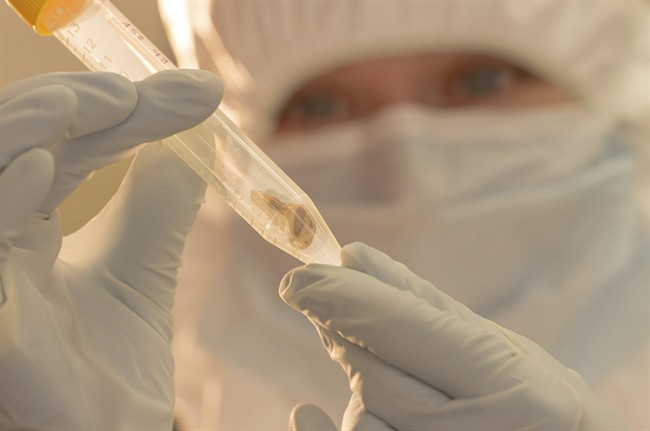Teeth from four French women and two Quebec residents who died hundreds of years ago show the telltale signs of vitamin D deficiency, a new study says.

Lori D’Ortenzio, a PhD candidate in anthropology at McMaster University in Hamilton, came up with the idea to use teeth to detect vitamin D deficiency though people in her field usually deal with bones.
Unlike bones, teeth store a permanent record of microscopic abnormalities in layers of dentin, beneath the enamel, akin to the rings of a tree that begin to develop before birth, said D’Ortenzio, who led the study.
Researchers analyzed a total of 12 teeth from four women who were buried in a French cemetery between 1225 and 1798 and two people who were buried in rural Quebec between 1771 and 1860, a child believed to be three years old and a 24-year-old man.
READ MORE: Here’s how removing fluoride from Calgary’s water affected kids’ teeth
An examination of three of the man’s teeth showed he’d suffered four bouts of rickets before he turned 13, D’Ortenzio said.
“We correlated the age at which the tooth was forming, with the location of the defect in the tooth. For example, if it was under the crown, it was earlier in the formation of that tooth, if it was in the root it would have been a little bit later.”

Get weekly health news
The researchers found that all the subjects had vitamin D deficiency, or rickets, which is a weakening of the bones caused by an extreme lack of the vitamin.
Their findings were published Tuesday in the Journal of Archaeological Science.
“We thin-sectioned the teeth and low and behold, there were these defects in the teeth,” said D’Ortenzio, describing the severe cases as resembling bubbles.
READ MORE: Tooth decay ‘epidemic’ in Canada could be linked to too much fruit juice, study suggests
Researchers also had access to some of their subjects’ bones, which showed deformities.
“So we knew that these individuals had rickets or had cases of rickets episodes when they were children,” she said.
Vitamin D deficiency can be detected with a blood test and most cases are caused by a lack of sun exposure, but some health conditions including celiac disease can also lead to rickets.
D’Ortenzio said the subjects would have depended on sunlight for their major source of vitamin D, which is fat soluable and available in food such as salmon and eggs. Milk and non-dairy beverages and some orange juice brands are fortified with vitamin D.
Out of curiosity, D’Ortenzio had her 19-year-old son tested and discovered he was deficient in vitamin D, as was a professor in her department, who also got tested.
READ MORE: Is milk good for your bones? Study casts doubt
Low levels of vitamin D, which is needed to absorb calcium from food, can increase bone loss, leading to a risk of fractures.
Health Canada’s daily recommended intakes for vitamin D are 400 international units for infants, 600 IU for children aged one through adulthood, and 800 IU for people over 70.
Stephanie Atkinson, a professor of pediatrics at McMaster University, where she is also a researcher in bone and mineral metabolism, said pregnant women need to ensure they get enough vitamin D because “even your permanent teeth start forming in utero.”
Breast milk doesn’t have enough vitamin D so babies should be given drops of the vitamin to prevent nutritional rickets, Atkinson noted.
READ MORE: When should kids go to the dentist? 40 per cent haven’t been by age 4
On Tuesday, the Food and Drug Administration in the United States announced it has changed its regulations to allow manufacturers to increase the level of vitamin D in milk and add fortification to more plant-based dairy beverages and yogurt alternatives.
“I know for a fact that Health Canada is undergoing similar considerations to improve the vitamin D content of available foods in the marketplace,” Atkinson said.
— Follow CamilleBains1 on Twitter.





Comments